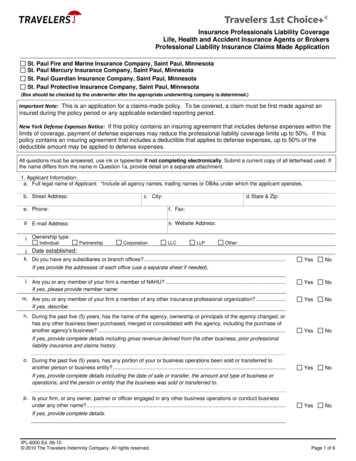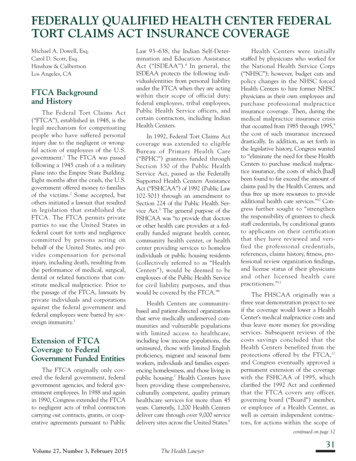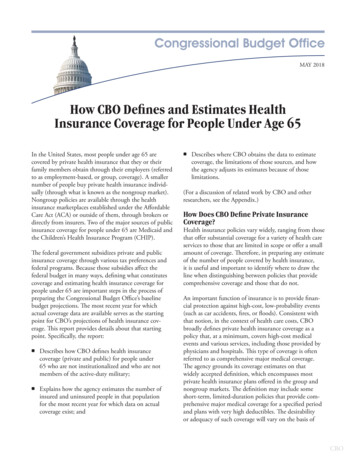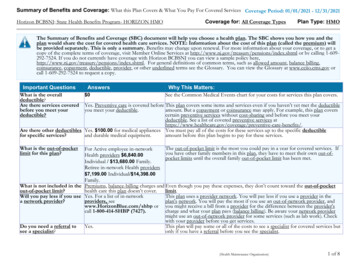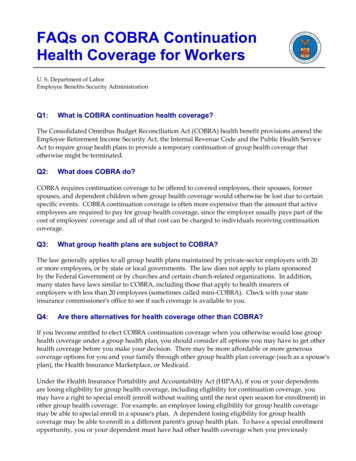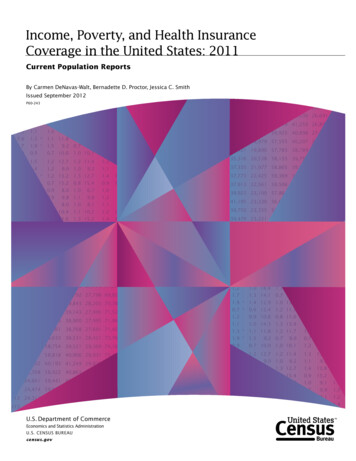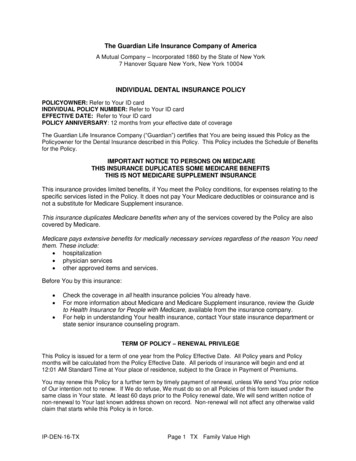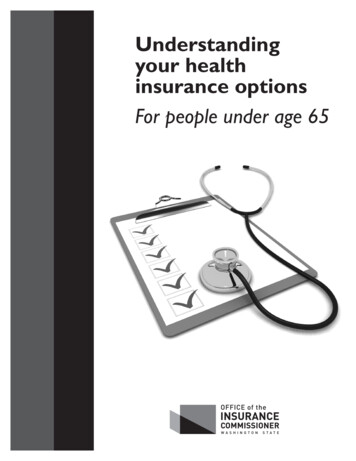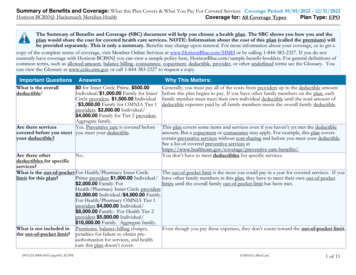
Transcription
Health and Insurance Coveragefor Residents and FellowsJuly 1, 2021 – June 30, 2022Summary of BenefitsYour UC Health &Insurance CoverageLearn about the benefits available to you as a new University of Californiaresident or fellow.ucresidentbenefits.com
Get to Know Your UC BenefitsWelcome to UC. As a new resident or clinical fellow, you can enroll in benefitsthat provide health and other insurance. This summary provides an overviewof the coverage you’re eligible for beginning July 1, 2021.Who Is Covered by the Plans?Active residents and clinical fellows enrolled in a Graduate Medical Education (GME) Trainingprogram and working at least 20 hours a week are eligible for coverage in the UC medical, dental,vision, life and disability insurance plans. You can also cover your spouse or domestic partner anddependent children up to age 26 in medical, dental and vision coverage.Cost of CoverageUC pays the entire cost of coverage for you and your enrolled dependents.Information at Your FingertipsLearn more about all your benefits and watch new hire presentations atucresidentbenefits.com New Hire Benefits Presentation Video.Your Coverage OptionsMedical PlanMedical and behavioral health benefits will be provided through the Anthem Blue Cross PPO (preferred provider organization)starting July 1, 2021. The plan covers services such as preventive care, doctor's office visits, hospitalization and prescriptiondrugs. You can get care from any doctor or facility. But you’ll pay less out of pocket when you see a UC Medical Center orAnthem provider.
What You Pay for Medical CareAreas of InterestTier 1: UC Medical CenterTier 2: Anthem PPONetwork ProviderTier 3: Out-of-NetworkProvider1Benefit-year deductible2 0Self: 100Family: 200Self: 200Family: 500Out-of-pocket maximumSelf: 1,000Family: 2,000Self: 1,000Family: 2,000Self: 2,000Family: 4,000Preventive care3 0 0 0Doctor, specialist and therapistoffice visits 15 copayment 15 copayment30%Virtual care (LiveHealthOnline and LiveHealth OnlinePsychology)Not applicable 15 per visitNot applicableUrgent care visits 15 copayment 15 copayment30%Emergency room visits 0 100 copayment(waived if admitted) 100 copayment(waived if admitted)Inpatient hospitalization4 250 copayment10%30% plus any amount overAnthem’s 600 maximum fornon-emergencies 10 for Tier 1 generic drugsPrescription drugs: Retail(30-day supply) 10 for Tier 1 generic drugs 20 for Tier 2 preferred brand drugs 20 for Tier 2 preferred branddrugs 40 for Tier 3 non-preferred brand/generic and specialty drugs 40 for Tier 3 non-preferred brand/generic and specialty drugsYou can get 90-day fills at AnthemRetail90 pharmacies for 3 timesthe copayment. 10 for Tier 1 generic drugsPrescription drugs: Mail service(90-day supply) 30 for Tier 2 preferred branddrugs 50 for Tier 3 non-preferred brand/generic and specialty drugs50% of the cost (up to 250per prescription, retail only) 10 for Tier 1 generic drugs 30 for Tier 2 preferred brand drugs 50 for Tier 3 non-preferred brand/generic and specialty drugsNot covered1. In addition to any deductible and coinsurance, you are responsible for any billed charge that exceeds Anthem’s maximum allowed amount for services provided by an out-of-networkprovider. For outpatient non-emergency services or surgery at an out-of-network facility, the maximum plan payment amount is 350 per day. For outpatient surgery at an out-ofnetwork ambulatory surgical center, the maximum plan payment amount is 350 per day. For inpatient non-emergency services at an out-of-network facility, the maximum planpayment amount is 600 per day.2. In-network and out-of-network benefit-year deductibles are separate — what you pay toward one doesn’t count toward the other. UC Medical Center deductibles apply to the AnthemPPO in-network deductible. The deductible and out-of-pocket maximum reset every year on July 1.3. Not all services provided during a preventive care visit are considered preventive health benefits. For more information about what services are covered, go to anthem.com/ca.4. An additional copayment of 250 applies if you do not receive preauthorization for out-of-network providers.DefinitionsBenefit-year deductible: The amount you pay for medical and behavioral health services before the plan begins to share in the cost for covered services.Out-of-pocket maximum: The most you pay for covered medical and behavioral health services, including prescription drugs, in a benefit year.Preventive care: Annual screening and lab tests based on your age and gender.
Dental PlanYou have the option to see any dentist you want, but you’ll pay less when you visit a Delta Dental PPO (DPPO) in-networkdentist, and there’s no deductible to meet. You can also choose to get care from a Delta Dental Premier dentist or an out-ofnetwork dentist, but your costs will be higher and you’ll need to pay the deductible. UC pays the entire cost of coverage.You pay only the out-of-pocket costs for the care you receive.What You Pay for Dental CareAreas of InterestDelta Dental PPO DentistDelta Dental Premier DentistOut-of-Network Dentist5 0Self: 50Family: 150Self: 50Family: 150 1,500 1,500 1,500 0 0 010%20%20%10%20%20%Calendar-year deductibleThe amount you pay for services beforethe plan begins to share in the cost forcovered servicesCalendar-year maximumThe maximum benefit the plan pays foreach member for all services combinedDiagnostic and preventivecareCleanings, exams and X-raysBasic servicesAnesthesia, root canals, simple andsurgical extractionsMajor servicesCrowns, inlays, veneers, implants,bridgesOrthodontiaFor children and adults50% plus any amount over the 1,000 lifetime maximum5. In addition to any deductible and coinsurance, you are responsible for any billed charge that exceeds Delta Dental’s maximum allowed amount for services provided by anout-of-network provider.
Vision PlanExams and lenses are covered once every 12 months, with a small copayment for each, when you see a Vision Service Plan(VSP) provider. The plan also covers a portion of the cost of contact lenses and frames. UC pays the entire cost of coverage.You pay only the out-of-pocket costs for the care you receive.What You Pay for Vision CareAreas of InterestAnnual eye exam andvision screeningVSP ProviderOut-of-Network Provider 10 copaymentAny amount over the 50 allowance 25 copaymentNot applicableAny amount over the maximum allowance (up to 150 depending on the frame), plus a 20% savingsafter the allowanceAny amount over the 70 allowance(once every 12 months)Prescription glassesFrames(once every 24 months)Lenses(once every 12 months)Included in prescription glasses copayment: Single-vision, lined bifocal and trifocal lenses Polycarbonate lenses for covered children Tints and photochromics Standard progressive lensesEnhancements: Premium progressive lenses: 80– 90 Custom progressive lenses: 120– 160Single-vision: Any amount over the 50 allowanceLined bifocal: Any amount over the 75 allowanceLined trifocal: Any amount over the 100 allowanceProgressive lenses: Any amount over the 75 allowanceTints: Any amount over the 5 allowanceDiscount of 35%–40% on other lens enhancementsContact lenses(once every 12 months)In lieu of frame and lenses: Fitting and evaluation: Up to 60 copayment Lenses: Any amount over the 130 allowanceAny amount over the 110 allowanceGroup Life and Disability InsuranceYou’re automatically enrolled in life, accidental death and dismemberment (AD&D), and disability insurance at no cost to you.These plans — administered by Cigna Insurance Company — may pay a cash benefit if you die or become seriously injured.Group Life and AD&DThe group life insurance and AD&D benefit amounts are each 50,000.Short- and Long-Term Disability ProgramIf you can’t work for 30 continuous days because of a disability, your short-term disability (STD) benefits may pay up to66.67% of your salary ( 1,200 weekly maximum) for up to 22 weeks.If you are still disabled after 22 weeks, you may be eligible for long-term disability (LTD) benefits that replace up to 66.67%of your salary ( 5,000 monthly maximum) until you no longer meet the definition of disabled or you reach Social Securitynormal retirement age.
Flexible Spending AccountsFlexible spending accounts (FSAs) allow you to set aside pretax dollars from your paycheck to use toward eligible health careand dependent care expenses. Essentially, you pay yourself back with tax-free money for expenses you’d have anyway, such asfor doctor’s office visits and prescriptions, or child care expenses.There are two accounts to choose from: a Medical FSA, used to pay for health care expenses, and a Dependent Care FSA,used to pay for child care expenses. Both accounts are administered by WEX.Residents and fellows who are partially funded on T32 grants received through the UCPath payroll system can makepretax deductions against their UC pay only. Monthly election amounts cannot exceed your monthly UC pay.Medical Flexible Spending Account (FSA)Dependent Care FSAThe Medical FSA lets you set aside pretax money fromyour paycheck to use for eligible health care expenses,such as:The Dependent Care FSA lets you set aside pretax dollarsfrom your paycheck to use for eligible out-of-pocket childcare expenses, such as day care, after-school programsand day camps for dependents up to the age of 13. It alsocovers care costs for disabled dependents of any age,including your spouse.§ Copayments and coinsurance for doctor’s office visits,lab tests, hospital stays and more§ Prescription drugs and over-the-counter medications,like allergy, asthma and cold/flu medicines§ Birthing and Lamaze classes§ Dental and orthodontia treatment§ Vision care, including glasses, contact lenses and moreContribution LimitsIn 2021, you can set aside up to 2,062 in your MedicalFSA. Consider your health care expenses from previousyears to estimate how much you should contribute toyour account, and keep this in mind:§ You can enroll as of your program start date, andthen file claims incurred on or after the first of thefollowing month.§ The full amount you elect to contribute for theremainder of 2021 will be available to you startingJuly 1, 2021.§ You have until March 15, 2022, to submit claims forreimbursement of expenses incurred between yourplan effective date (usually your program start date)and December 31, 2021.Use it or (mostly) lose it! You can roll over upto 550 each benefit year. Any balance over thatamount is forfeited. Carefully plan expenses up untilDecember 31, 2021. You may submit claims for eligibleexpenses incurred through your last day of 2021. Youmay only make changes to your election if you havea qualifying status change.Contribution LimitsYou can contribute up to 5,000 ( 2,500 if marriedand filing a separate tax return) each benefit year. Thismaximum limit applies to your entire household, so ifyou are married or have a domestic partner who alsocontributes to a Dependent Care FSA, the combined totalyou both can contribute is 5,000. When considering howmuch to contribute, keep this in mind:§ You can enroll as of your program start date, andthen file claims incurred on or after the first of thefollowing month.§ You can request reimbursement up to your accountbalance. You will likely need to hold your dependentcare expenses and submit them later in the year to buildenough money in your account for reimbursement. Or,you can submit all of your dependent care expenses atthe end of the benefit year and receive one lump-sumreimbursement.§ You have until March 15, 2022, to submit claims forreimbursement of expenses incurred between yourplan effective date (usually your program start date)and December 31, 2021.Use it or lose it! Any money remaining in your accountafter April 1, 2022, is forfeited. Carefully plan expensesup until December 31, 2021. You may submit claims foreligible expenses incurred through your last day of 2021.You may only make changes to your election if you have aqualifying status change.Watch a short presentation to learn more about flexible spending accounts atucresidentbenefits.com Flexible Spending Accounts.
How to EnrollYou can enroll in your health and insurance benefits beginning June 1, and you haveuntil June 15 to complete your enrollment. You will receive your medical ID card shortlyafterward and can begin using your benefits on your program start date.To enroll in health and insurance benefits:To enroll in a flexible spending account (FSA):1. Log in to PlanSource: benefits.plansource.com.Once you are set up in the UCPath payroll system, youcan enroll in the FSAs. Visit UCPath Benefit Enrollment.Click the Open button to make your FSA elections. It maytake a few seconds for you to see the FSA options.2. Your temporary username is the first letter of yourfirst name the first 6 letters of your last name thelast 4 digits of your Social Security number.3. Example: Username for John Hancock (Social Securitynumber is 123-45-6789) is jhancoc6789.4. Your password is your birthdate (YYYYMMDD). You’llbe prompted to change your temporary username andpassword following your initial login.5. Enroll yourself and dependent(s) in coverage,then add your address and beneficiaries for lifeinsurance benefits.6. ID cards: You’ll receive a new ID card from Anthemwithin 10 days of your effective date. Your programstart date (your effective date) is also when yourcoverage begins. You can view your effective dateon PlanSource.For questions about your benefitsor if you need help enrolling,contact your Human Resourcesoffice at (916) 734-1499 orhrsingleteary@ucdavis.edu.This summary of benefits is a brief outline of coverage, designed to help you with the selection process. This summary does not reflect each and every benefit, exclusion and limitationwhich may apply to the coverage. For more details, important limitations and exclusions, please review the Benefit Plan Summary. If there is a difference between this summary and theBenefit Plan Summary, the Benefit Plan Summary will prevail.
Resources to support youMedical/Pharmacy/Behavioral HealthVirtual CareAnthemanthem.com/caLiveHealth Onlineanthem.com/ca Log In LiveHealth Online(855) 603-7985Anthem PPO members can call toll-free(833) 674-9256, Monday through Friday,8 a.m. to 8 p.m. PT. Pharmacy representativesare available 24/7.DentalDelta Dentaldeltadentalins.com(800) 765-6003Download the mobile app from the App Storeor Google Play.LiveHealth Online Psychologyanthem.com/ca Log In LiveHealth Online LiveHealth Online Psychology(844) 784-84097 a.m. to 11 p.m. (in any time zone)Life and DisabilityCignacigna.com800-36-CIGNA (800-362-4462)VisionFlexible Spending AccountsVSPvsp.com(800) 877-7195WEXwexinc.com Products WEX Benefits Platform FSA(866) 451-3399Human ResourcesHolly Singletearyhrsingleteary@ucdavis.edu(916) 734-1499ucresidentbenefits.comUNIVERSITY OF CALIFORNIA HEALTHCARE PLAN NOTICE OF PRIVACY PRACTICES—SELF-FUNDED PLANS The University of California offers various health care options to its employees, retireesand their eligible family members through the UC Healthcare Plan. Several options are self-funded group health plans for which the University acts as its own insurer and provides funding to paythe claims; these options are referred to as the “Self-Funded Plans.” The Privacy Rule of the federal Health Insurance Portability and Accountability Act of 1996, also known as HIPAA, requires theSelf-Funded Plans to make a Notice of Privacy Practices available to plan members. The University of California Healthcare Plan Notice of Privacy Practices—Self-Funded Plans (Notice) describesthe uses and disclosure of protected health information, members’ rights and the Self-Funded Plans’ responsibilities with respect to protected health information.UC’s Self-Funded Plans for 2021 include the UC Resident and Fellow PPO Plan, the UC Resident and Fellow HMO Plan, the Delta Dental PPO and the Vision Service Plan (VSP). A copy ofthe updated Notice is posted on the ucresidentbenefits.com website, or you may obtain a paper copy of this Notice by contacting your campus GME office. The Notice was updated to reflect thecurrent health care plan options effective July 1, 2021. If you have questions or for further information regarding this privacy Notice, contact the UC Healthcare Plan HIPAA Privacy Officer atpolicyoffice@ucop.edu.Health and Insurance Coveragefor Residents and FellowsUCD-res-plan-brochure-21
hours a week are eligible for coverage in the UC medical, dental, vision, life and disability insurance plans. You can also cover your spouse or domestic partner and dependent children up to age 26 in medical, dental and vision coverage. Cost of Coverage. UC pays the entire cost of coverage for you and your enrolled dependents.
